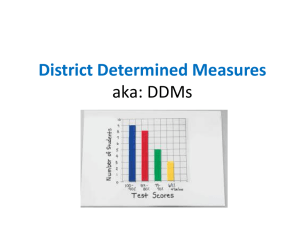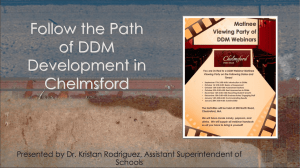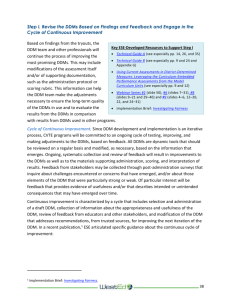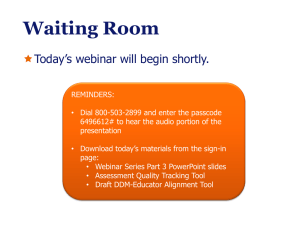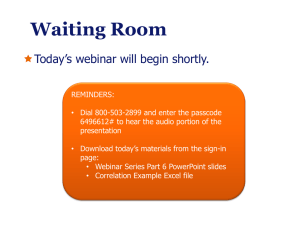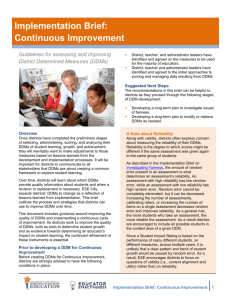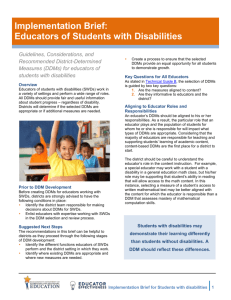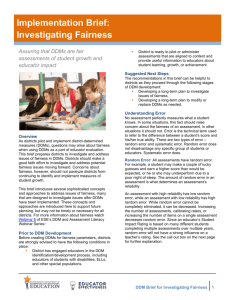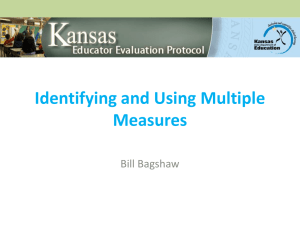DDM PowerPoint - Chicopee Public Schools
advertisement
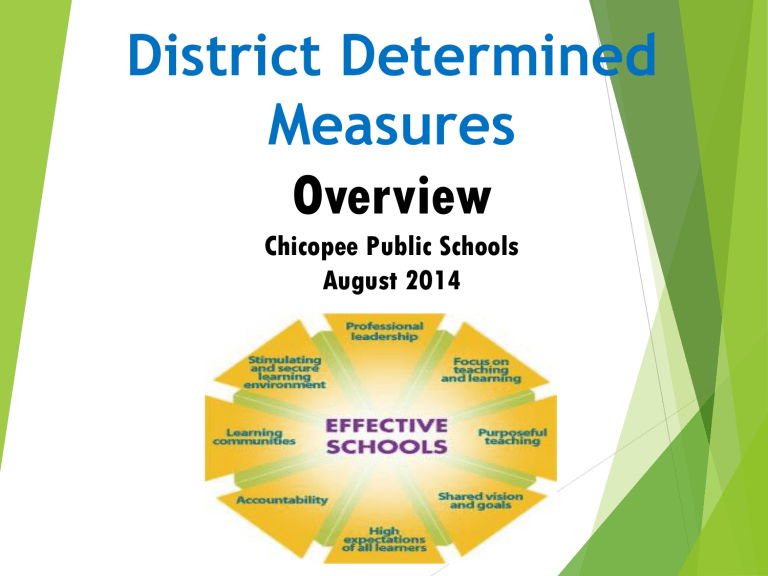
District Determined Measures Overview Chicopee Public Schools August 2014 What are DDMs? Measures of teacher impact on student learning, growth, and achievement Aligned to MA Frameworks Comparable across grade/subject are District-wide Can be district-or teacher=developed, or text=book based. Test common among like components, i.e. sixth grade math, Spanish 1 MA Education Laws and Regulations Final Regulations on Evaluation of Educators 603.CMR 35.02 2 http://www.doe.mass.edu/lawsregs/603cmr35.html?section=02 Breaking It Down…. Think of a DDM as an assessment tool similar to *MCAS/PARCC. It is a measure of student learning, growth, and achievement related to MA curriculum frameworks or other relevant set of standards for a particular discipline. But, a DDM can also be unlike MCAS: A portfolio A capstone project A commercial assessment (e.g., DIBELs, Discovery and SRI) ACCESS for ELLs Indirect measures: Attendance/discipline/graduation rates, course taking patterns, social/emotional/behavioral learning over time. Useful for Specialized Instructional Support Personnel (SISP). *Any further reference to MCAS will include PARCC 3 What Qualities Must a DDM Have, especially since it is tied to teacher evaluation? 1. Must be aligned to and target the most the important learning standards, or objectives/student outcomes, for grade level & content area (content validity). 2. Must be informative: informs educators about where students fall short or excel; measures students’ progress/growth effectively. Tells us something useful. 3. Must be free of any bias; all groups of students should have an equal chance to demonstrate growth. 4. Has common administration protocols. Note: Testing accommodations on a student’s IEP must also be implemented for DDMs. 5. Has a common scoring process. Current scoring processes will be reviewed during 2014-15 pilot year. 6. Will yield a range of performance & growth: high, moderate, low. Recommended Moderate = 1 year’s progress. Needs to discriminate between strong and weak performers. 4 7. Are equally rigorous across schools, grades, and content areas. Four Basic Types of DDMs 1. Pretest and Posttest 2. Repeated Measures (done in short, regular intervals: e.g., DIBELs Next, District Writing Benchmarks) 3. Holistic Evaluation (e.g., portfolio) 4. Posttest only (e.g., end of unit, term, or course assessments; capstone project) Note: A DDM should show growth/achievement over a year/course. 5 6 7 Key Questions Our Committees Used When Developing DDMs 8 DDM Options Used By Our District 9 Each DDM Includes: 10 11 1.They access growth/achievement in a specific subject-area/grade-level over time. 2.They use baseline and end-of-year (or unit, term, etc.) assessment data to measure growth/achievement 12 Examples of Growth and Achievement Growth SGP (student growth percentile): The result of a statistical model that calculates each student’s change in achievement between two or more points in time on a State assessment or other comparable measure and compares each student’s performance to that of similarly achieving students Achievement Pre-Posttest Student gains to be measured as a change in student learning over time; that is, it should measure the difference between a baseline assessment and a post-assessment covering similar concepts and content 13 CPS Rubrics: 2 Definitions Scoring Rubric A scoring rubric is an evaluation tool to measure progress against a consistent set of criteria. Rubrics clearly define academic expectations for students and help to ensure consistency in the evaluation of academic work from student to student, assignment to assignment, or course to course. Rubrics are used as scoring instruments to determine the degree to which learning standards have been demonstrated or attained by students over time. Student Impact Rubric A student impact rubric is an evaluation tool to measure the growth/achievement students have made on designated DDMs. These rubrics can be developed for subgroups as well as general education students. The designation will be either low, moderate or high impact. 14 DDM Results 1.Should be compiled and reported by educators to evaluators using text, graphs, or images. 2.Should assist educators to draw conclusions. 3.Should guide educator’s instruction and drive meaningful change. 4.Should align with an educator’s goals, as they will serve as evidence of progress. 15 16 *Educator’s Student Impact Rating indicator not reported for SY14-15 What is Required of All Chicopee Educators? At least 2 DDMs per educator used over a 2 year period to measure Impact on Student Learning (typically for not the same students). 2013-14 (SY14): Piloted as many DDMs as possible. 2014-15 (SY15): Chicopee has been granted an extension; so we have SY15 to pilot all measures with the goal of student impact rating to be in place for SY16. 2015-16 (SY16): As part of Educator Evaluation, educators receive first data collection for Student Impact Rating (high, moderate, low). 2016-17 (SY17): As part of Educator Evaluation, educators receive second round data collection and first report of Student Impact Rating. Rating will be based on two years of data and collaborative (educator/evaluator) professional judgment. Note: “Moderate” growth is defined as 1 year’s progress/growth over 1 year’s time and relative to one’s academic peers; the amount of growth we would reasonably expect for a student over one school year relative 17 to his/her academic peers. Why 2 DDMs?? The state is requiring each educator to have a minimum of 2 DDMs in place for Student Impact Rating reporting by SY 2017. More than 2 DDMs for content and indirect measures may be identified. Once an assessment has been identified as DDM, ALL students in similar classes/subjects MUST take the DDM. The educator/evaluator choose the DDMs to be used as part of the student impact rating. Even if the DDM data is not being used for Evaluation – students must take DDMs once the assessment is identified as a District Determined Measure. The thought is that in the future educators/evaluators might want to look at results of more than 2 DDMs to enrich professional discussions about student learning. 18 19 Two Ratings 20 Summative Rating Example 1 Exemplary Proficient 1-yr SelfDirected Growth Plan 2-yr Self-Directed Growth Plan Needs Improvement Directed Growth Plan Unsatisfactory Improvement Plan Low Moderate High Rating of Impact on Student Learning 21 Summative Rating Example 2 Exemplary Proficient 1-yr SelfDirected Growth Plan 2-yr Self-Directed Growth Plan Needs Improvement Directed Growth Plan Unsatisfactory Improvement Plan Low Moderate High Rating of Impact on Student Learning 22 Summative Rating Example 3 Exemplary Proficient 1-yr SelfDirected Growth Plan 2-yr Self-Directed Growth Plan Needs Improvement Directed Growth Plan Unsatisfactory Improvement Plan Low Moderate High Rating of Impact on Student Learning 23 Student Impact Rating Evaluators must assign a rating based on trends (at least 2 years) and patterns (at least 2 measures). First Student Impact Rating data collection will be done in SY2016 and reported in SY2017. Options – 603 CMR 35.09(3)(a-c) high indicates significantly higher than one year's growth relative to academic peers in the grade or subject. moderate indicates one year's growth relative to academic peers in the grade or subject. low indicates significantly lower than one year's student learning growth relative to academic peers in the grade or subject. 24 Student Growth Percentile (SGP) from MCAS as Growth Measure Scores not available until fall of following year Student impact rating only determines a one, or twoyear plan, and is a separate rating from the Summative Rating, which determines the type of Plan you will be on The State determines the SGP range annually LOW MODERATE HIGH 34 35 - 65 66 25 2 DDMs over 2 Years: Some Scenarios If you teach or do… You need or can use… Multiple subjects (e.g., K/elementary level). 1 DDM for ELA; 1 DDM for math (must use 1 MCAS SGP; can use both ELA & Math SGP). One subject or grade level course only (e.g. middle school). 2 DDMs for that subject or course for all sections (1 must be MCAS SGP for ELA & math teachers). Multiple courses and/or grades (e.g., high school). Specialized Instructional Support (for SISP). Co-Teachers/“Interventionists” (e.g. Title 1, ELL, SPEd): use same DDMs/SGPs. You and your evaluator will need to identify which two courses’ DDMs to use that best capture the core of your work. Portfolio; Indirect Measures (e.g., attendance, discipline, or behavioral data, etc.). Use same DDMs and SGP as classroom teachers. MCAS mandated for 20+ students in each grade. 26 All students must take required DDMs regardless of use for educator evaluation. MCAS Science not tested every year; SGP unavailable. 27 Our Impact ‘My role, as teacher, is to evaluate the effect I have on my students.’ It is to ‘know thy impact’, it is to understand this impact, and it is to act on this knowing and understanding. It requires that teachers gather defensible and dependable evidence from many sources, and hold collaborative discussions with colleagues and students about this evidence, this making the effect of their teaching visible to themselves and others” ~John Hattie 28 Visible Learning For Teachers What Needs to be Done by When? By June 1, 2014, all districts submitted to DESE a DDM implementation plan for 2014-15 onward. Chicopee has been granted an extension. District DDM Plan indicated two DDMs to be developed and used for each grade level, course, or role. District committees (elementary & secondary) have been formed to design all DDMs before they are piloted as part of Educator Evaluation. The pilot will include how to use DDM results related to Student Impact Rating. 29 30 31 Any Questions ???? 32
